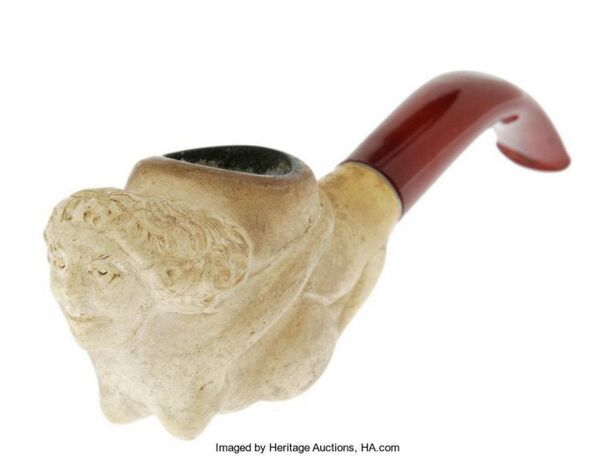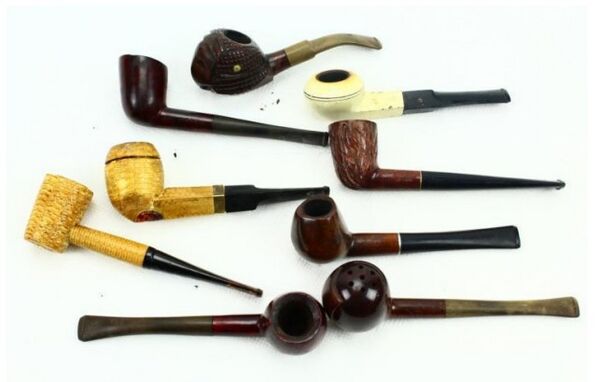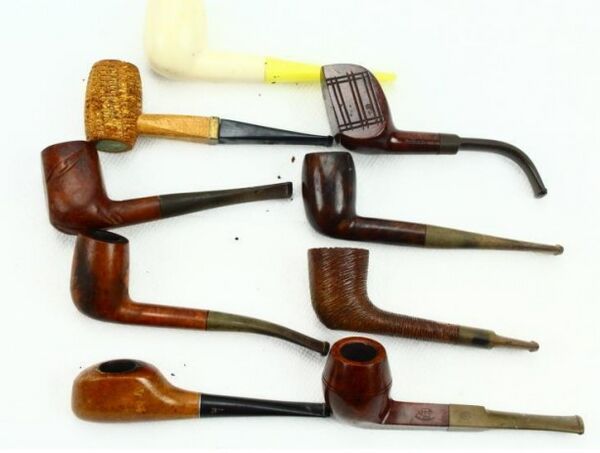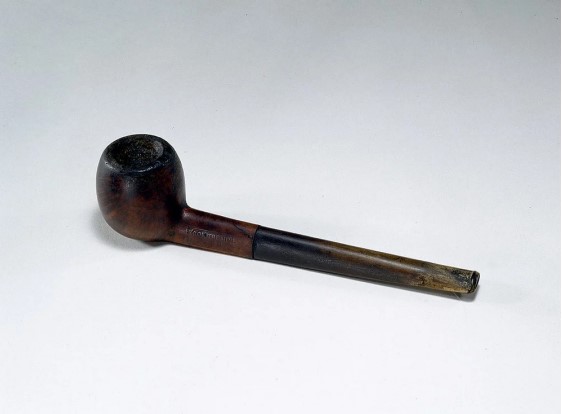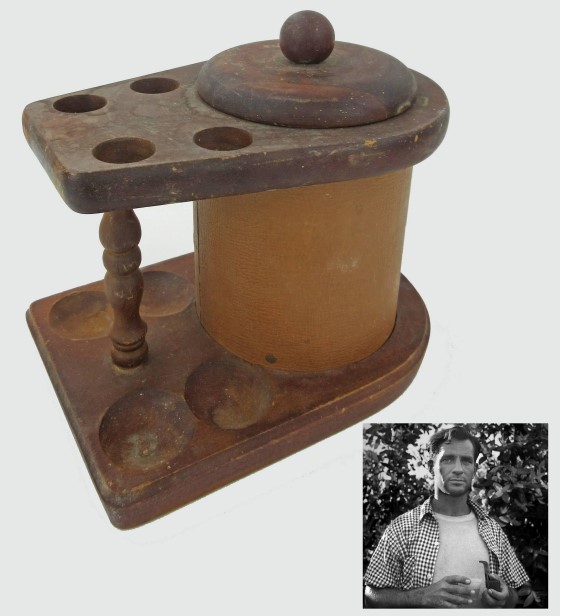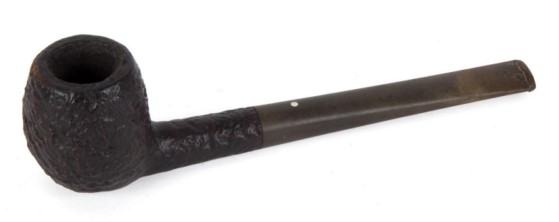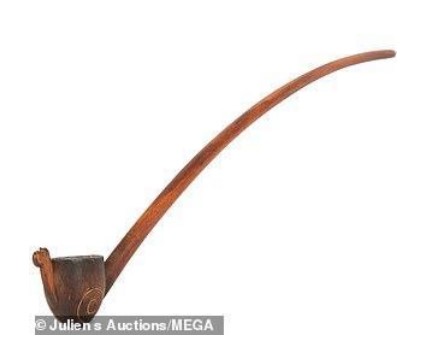1-2-3 Sold! Recent Pipe-Auction Action
Exclusive to pipedia.org
One venue to grow a pipe collection is the public auction. Auctions are adrenaline-fueled displays of nervy body language, calculated action and strategic thinking. If you find a desired item, you may be willing to pay significantly over market value to own it. Emotional value can make deciding a price difficult for buyers, especially for an item that someone really desires and that is worth almost any price. Sometimes, you have to go with your heart. If the item holds more emotional value, the market and auction values may not be as important. Provenance, rarity, quality, and other factors, of course, are the significant determinants. The act of bidding at auction presents challenges, including overconfidence that often prompts irrational and foolish behavior.
Recently, the realized prices for tobacco pipes at public auctions have often defied explanation. Some prices have shocked the pipe-buying world; others have been outrageous in relation to House estimates that are often conjecture; although they are unbiased, estimates are, more often than not, unreliable market indicators. As any bidder knows, in an ascending auction, price and allocation are determined in an open competition among bidders; they provide a process of price discovery. Bidders willing to pay the most win and pay prices that no other bidders are willing to top. Faulty valuations play a role in overbidding and the ensuing winner’s curse. Value is socially determined through the escalation of bids. “Beauty is in the eye of the beholder” and, in an auction, worth is in the eye of the bidder. Is it worth it? A more personal question: is it worth it to you? Cost alone is not the only consideration in bidding. Two intangible factors that drive bids are also in play: utility and enjoyment.
There is a science to bidding at auction. Paul R. Milgrom and Robert J. Weber, “A Theory of Auctions and Competitive Bidding” appeared in Econometrica, Vol. 50, No. 5, September 1982. There’s R. Preston McAfee and John McMillan, “Auctions and Bidding” (Journal of Economic Literature, June 1987). In 2004, Jonathan Levin published a mathematical model, “Auction Theory” (web.stanford.edu). In 2009, Warren J. Hahn et al. published “The Winner’s Curse and Optimal Auction Bidding Strategies” (gbr.pepperdine.edu). “The Psychology of Bidding at Auction” is at dakil.com. And some sound bidding tips are at “Auctions 101: Expert tips for novice bidders” (liveautioneers.com).
EBay began as an Internet auction marketplace but it has, of late, leaned toward a fixed-price format, so I do not consider it a typical public auction. According to a study of eBay auctions in 2007, “The Bidder’s Curse,” economists Young Han Lee and Ulrike Malmendier discovered that “… when including shipping costs, the average eBay auction winner overpaid by 73 percent in their winning bid for a given item. Those buyers could have paid considerably less by buying the exact same item through a fixed-price eBay listing.” Some argue that eBay bidding practices, such as zero feedback bidders and the fixed-time, semi-sealed-bid modified second-price (Vickery) format (whatever that is) are unfair. If you’re not happy with eBay, maybe you prefer to bid on TinBids.com (billed as “The Pipe Collector’s Auction Site”), cigarbid.com (“Here is where you’ll find all of our pipe and pipe tobacco lots up for bid”), pipestud.com, or London Calling with Simon. A less-familiar auction site that occasionally offers a variety of pipes is catawiki.com situated in the Netherlands. The owner, Arjan deHaan, has hosted three auctions so far: “First Time Specialty Antique Pipes Auction” in August–September 2021, and two in June 2023 that ran concurrently, “Pipe Decorative Objects” and “Smoking Accessory Auction.”
Maybe you don’t have the bidding-war gene. Maybe you don’t like the idea of not knowing the final cost at a public auction: you compete against other (unknown) and phantom bidders, you win, then you have to pay the sacrosanct buyer’s premium (it can be as much as 20–25 percent) and, if you are not in attendance, shipping and insurance fees. If you are risk-averse, you probably prefer to buy in a less-stressful environment: at a pipe show, from your neighborhood pipe shop, from a pipe friend, or from Tobacco Pipes Rummage Group (facebook.com), because you’d know the exact cost and the competition is zero. Or you can buy from an online retailer. (I’m not promoting smokingpipes.com, but did you know that it has several hundred estate pipes for sale?)
I wrote “Where’s The Real Pipe Action? I Say It’s At The Auction Block!” for Pipes and Tobaccos’ Web Extras (now defunct) that can now be read at pipedia.org. Although I gave up collecting pipes a handful of years ago, I still follow the auction scene, so this, another tobacco tell-all, is what’s been happening these past few years.
First, a bit of cautionary bidding advice from Jason Harris (“Piping Hot: History of Tobacco Pipes”): “Remember to look at the condition of the piece, take note of its origins, material, age, and authenticity if one wishes to avoid burning money on an item that is not what it presents itself to be.” One recent auction experience with condition should suffice to support his assertion. In March 2023, this antique meerschaum cheroot holder was in an online Templum Fine Arts auction in Barcelona, Spain: “LOS 403: Rara y Excepcional Pipa en Espuma de Mar y boquilla en Ámbar Representando a la Diosa Cibeles, siglo XIX” (Rare and Exceptional Sea Foam Pipe and Amber Mouthpiece Representing the Goddess Cibeles, 19th century). Cybele was a Greek goddess often depicted riding a chariot drawn by two lions. Interestingly, the Plaza de Cibeles in Madrid has a monument—the Cibeles fountain—dedicated to her, so this pipe has an interesting provenance. The House estimate was 4,500–5,000 Euros (c. $4,845–$5,400), but no condition report was included.
Its motif and size appealed to several of my pipe-collector friends. While the bidding was heating up, I asked the House for a condition report and advised that it needed to change the description from pipe to cheroot holder. This was the response from the auction Director, Carlos Viñas: “No makers [sic] name. Please find attached additional pictures. Pipe has some restoration areas, glued in the middle (amber is in good condition), need some repairs and overpaint.” So much for truth in advertising. I informed my friends, and they withdrew their bids. Nevertheless, the holder sold at 2,500 Euros plus a 25% buyer’s premium or $3,350.
What follows is a series of pipes at public auctions held within the last five to ten years. For a balanced report, I present an amalgam of pipes from today and yesterday. Some may be worthy of their realized prices … depending on your perspective. I can judge whether the realized prices for the antique pipes were reasonable, but I will not comment on the prudence of spending this kind of money on any of the briar pipes I have included. As to the sequence, I wanted to present the pipes in chronological order and by medium, but I was not always successful.
Briar pipe aficionados may remember when a retailer at an RTDA show in San Antonio in 2000 paid an insane $9,950 for a Ser Jacobo Gem Series Diamond Brillante Maxima briar.
Master pipe maker Lars Ivarsson of Denmark passed away in February 2018. His daughter, Nanna, donated one of his pipes to the Chicagoland Pipe Collectors Club convention in May of that year; on the shank was inscribed the date of his birth and death. A silent auction was conducted and the successful bidder won it for $23,000.

Several years later, an avalanche of very high-quality briars appeared at auction.
Several years later, an avalanche of very high-quality briars appeared at auction. Those who collect artisan and estate briars must have been ecstatic about the opportunities to bid at Taurus Auction of New Jersey. It’s had considerable success in five consecutive auctions of extraordinary briars—April 2021 (338 lots) and November 2021 (283 lots); March 2022 (276 lots), May 2022 (251 lots), and December 2022 (74 lots)—a total of 1,222 pristine pipes that, supposedly, belonged to one collector. I have selected a couple.
First, Michael Parks’ rendition of the ancient Pyramid, Chichén Itzá, at the Maya ruins, in the April 2021 auction? The estimate was $600–$800; the winning bidder paid $3,000.
From the November 2021 auction, this S. Bang Ramses estate pipe with an estimate of $400-$650 realized $1,300.
From the same auction, this S. Bang Volcano estate pipe, with an estimate of $400–$650, gaveled at $1,400.
And this Teddy Knudsen Eagle Grade Freehand estate pipe in the May 2022 auction had an estimate of $800–$1,600, and commanded a whopping $2,100! Unpredictable? Sure, but when does an opportunity like this occur? In this genre, lightning does not often strike twice.
No doubt the winning bids are justified, because of the rarity and desirability of these creations, even with a buyer’s premium of 18%. Strange, though, that in the Taurus April 2021 auction, there were 23 Dunhills—always a favorite brand among smokers—the highest bid of any was $800 for a 14kt-gold estate Spigot; the House had placed an estimate of $1,200–$1,800. Are you surprised?
Consider Britain’s Reeman Dansie’s “Specialist Collectors’ Sale” in March 2020, that included Lot 1939: “Dunhill root briar pipe, Dunhill pewter tobacco jar and pipe rest, Meerschaum pipe in case, other pipes, etc.” The winning bid for all this stuff was only £260 or about $334.
In Selkirk’s online auction, “SMOKE: Tobacciana & Smoking Accouterments,” April 20, 2022, were many pristine briars, each with a House estimate ranging in the low $100s, except one. It was the “Bagdad” briar from the Caminetto Prestige Collective series, with 18-kt yellow-gold fittings! The House estimate was $1,800 to $2,500. It passed…no takers.
I now address the auctions of pipes belonging to a certain class of pipe smokers: celebrities. There have been many such auctions in recent years; celebrity auctions are a global business. What is the appeal and value of anything that once belonged to a celebrity? The best answer is to excerpt “Worth Millions: Behind the Appeal of Celebrity Memorabilia” (Barnebys Magazine, August 22, 2021):
Fans and collectors alike are willing to pay mega sums for celebrity memorabilia. From used tissues to half-eaten toast, this is the psychology behind the phenomenon. …The prices fans and collectors willingly pay are representations of how much value is placed on these items. In fact, objects that have been in physical contact with celebrities—used, worn, or even just briefly touched—hold more monetary value than less personal possessions. …Maybe it’s the connection, the rarity, or the devotion. Whatever it is, the appeal of celebrity memorabilia is surely here to stay.
You first might want to read Laurie Jacobson’s “Hollywood Pipes” (pipesmagazine.com) to set the tone. You’d be surprised at some of the property from celebrities that has commanded big bucks at auction: John Wayne’s Stetson, Charlie Chaplin’s violin, John Lennon’s cufflinks, the headdress of Lawrence of Arabia, Errol Flynn’s wool cape, Elvis’s empty pill bottles, a lock of David Bowie’s hair, a chess set belonging to the Birdman of Alcatraz. On its website, Getty illustrates 738 celebrities smoking a pipe and, more specifically, tobaccopipes.com posts: “10 Famous Pipe Smokers: Hollywood.”
The Web is chock-full of articles about famous people who smoked a pipe, famous pipe smokers in history, famous writers who smoked a pipe, pipe-smoking actors, famous tobacco pipes, and such. This narrative is different. It’s about pipes belonging to celebrities, and their disposition after they departed this life or after they lost interest in smoking. (Near the end I include a few pricey pipes at recent auctions that are not from celebrities.) I would think that, at auction, the celebrity, not the pipes, would influence the price.
To be clear, celebrity pipes are something else entirely, at least to me … and there are plenty for sale on Etsy and eBay, such as this figural clay pipe of Gladstone. He was a celebrity.
Or the bust of former President Trump.
Many TV personalities and movie stars smoked a pipe on and off the set, and their pipes have appeared in a public auction. These pipes are attributed to the late British actor, Peter Cushing, who used them as props in his screen and stage roles, but they’re not for sale. They belong to Nuno Miranda, a collector of film and TV props.
I found more public auctions than I had expected. Unfortunately, in instances, the auction house, the auction date, the pipe images and other specifics are absent, so it’s impossible to determine whether the auctioned pipes were high-grade or drug-store variety. As you scroll through these auctions, keep in mind the fact that most auction appraisers do not have an understanding of pipe values, so estimates are, most likely, guestimates. Here’s one example: All I found was that Yul Brynner’s 30 pipes and two cigarette cases were auctioned in Paris in 1996.
I begin with Michael Richards (Cosmo Kramer in the TV sitcom, Seinfeld). The two pipes and a tobacco roll-up that he used as props were in the Dallas, Texas, Heritage Auction, “Signature Entertainment/ Music/Memorabilia” in October, 2007. The winning bid was $310.70.
Actor Glenn Ford. Heritage Auctions sold his pipe rack with six pipes in October 2008 for $537.75.
John Barrymore. In September 2010, Hake’s conducted a two-part online auction that included this Smoke Master briar pipe and Yello Bole cigar holder. The House placed a value of $400–$700, and a starting bid of $287.50. No takers.
Boston Celtics coach Red Auerbach. SCP Auctions sold his pipe rack with inset tobacco jar and eight briars in 2011 for $428.
Aaron Spelling. It was fairly well-known that the actor, writer and TV producer had a collection of some 600 Dunhill, Saseini 4-Dot, and S.T. Dupont pipes. Sometime after he died in 2006, Spelling’s estate contacted Kevin Godbee, who contacted Rick Newcombe and then onto Brian Levine and Sykes Wilford. In 2010, Brian, Kevin, and Sykes catalogued the collection at Pheasant Run during the Chicagoland Pipe Show in 2010. The extensive collection was available to the public but not in a public auction. Smokingpipes.com sold them all in 2011 and 2012. Kevin posted his involvement at pipesmagazine.com.
Orson Welles. In the March 2012 Nate D. Sanders Hollywood Memorabilia auction was “Lot 1550, Orson Welles Personal Signed Pipe Set. The eclectic pipe set includes eleven pipes from different worldwide pipe brands Oval wooden display unit holds a possible 24 pipes and features two glass tobacco jars with wooden lids in the center.” Minimum bid was $100; the realized price, $1,477.
William Faulkner. Chuck Stanion had written about his life in May 2023: “William Faulkner: Pipe
Smoker” (smokingpipes.com) in which he states: “We know he owned at least one Digby,
because it was auctioned in 2012.” It was also a well-known fact in other circles. Stephen J.
Gertz, “You Can Smoke William Faulkner’s Pipe For Only $3,000–$5,000” (booktryst.com). In
August 2012, PBA Galleries, Berkeley, California, conducted Sale 487, “Fine Literature.” Lot 100
was “Tobacco pipe owned and smoked by William Faulkner.” It was his Digby briar, a tobacco
pouch, and an empty Dunhill pipe box with an estimate of $3,000–$5,000 and a buyer’s
premium of 20 percent. You probably guessed it: it was unsold.
Thomas Kretschmann. In the 2015 Dracula Auction, there were no bidders for a lot that consisted of the pipe, matches, and tobacco pouch belonging to the not-so-celebrity Van Helsing.
Bing Crosby. The first mention of an auction from his estate after he died in 1977 was by Robert Lindsey in The New York Times article, “Memorabilia of Bing Crosby’s Houses Will Be Sold” (April 18, 1982); he listed many of Bing’s possessions, but pipes was were not mentioned. In the following month, another article in The New York Times: “From Pipes to Cars, Fans of Bing Crosby Buy Pieces of His Life” (May 30, 1982): “…1,400 lots of the late singer’s possessions, including his pipes, his golf clubs, pocket watches, gold clips and some of shirts, ties and socks.” The auction was to be conducted by Butterfield Auctioneers, San Francisco. However, I found this: “Fans, bargain hunters claim memories of Bing” (stevenlewis.info): “The 26 pipes offered for sale included some a foot long and others that were hooked with huge ceramic bowls. Some had ivory mouth pieces, others were briarwood.”
The first recent auction that included a Crosby pipe was the Heritage “Music/ Entertainment/Memorabilia Signature” auction in 2006. Someone paid $776.75 to win this Turkish meerschaum!
This next lot blows my mind. Bonhams, Los Angeles, conducted the “Entertainment Memorabilia including Animation Art” auction in November 2012. Are these three Crosby pipes worth the realized price of $1,187.50 including the premium?
In November 2017, GWS Auctions, Agoura Hills, California, sold most of the pipe collection from the estate in five lots. Lot 47E consisted of nine pipes with an estimate of $2,000–$3,000, and the gavel struck $275.
Lot 47F were nine pipes, estimated at $2,000–$3,000, but sold at $300.
Lot 59A, another nine pipes, also with an estimate of S1,500–$2,000, sold at $375.
Lot 59B, another nine pipes. With the very same estimate, this lot sold at $325.
Lot 59C consisted of eight pipes, with an estimate of $1,500–$2,000; the lot sold for $400.
Ain’t much to look at in any of the five lots, and the realized prices indicated as much. As recently as April 2023, Proctor Auctions, New Bern, North Carolina, “Discovery Auction 130” included Lots 39, 42, and 45, each consisting of “NOS 3 Bing Crosby Pipes” with the advisory “Price Realized Not Uploaded.”
Crosby was so admired that he has a following in today’s industry with pipes being made to memorialize him: The Peterson Bing, Sara Eltang’s Bing Crosby, Savinelli’s Bing Favorite series, at least two Dunhill shell briar Group 3 Bing Crosby pipes and the Dunhill County 4110 Bing Crosby, the Ser Jacopo Smooth L1, Merchant Service Bings, and Scottie Piersel’s Bing Crosby three-pipe set and stand. See Jeffery Sitts, “Bing Crosby: Singer, Actor, Pipe Smoker” (smokingpipes.com).
President Gerald Ford. The Heritage auction “Political, Western Legends & Americana Signature Auction” in December 2012, included this gift set of pipes from les Mâitres-Pipiers de Saint-Claude, France. The lucky bidder paid $3,346.
Albert Einstein. In Christie’s, London, auction, “Valuable Books and Manuscripts” in July 2017, among some of Albert Einstein’s collection of personal effects was this Davidoff sandblasted billiard with an estimate of 5,000–8,000 GBP. The realized price? It was tenfold more than the House anticipated, 52,500 GBP or $67,200. Someone wanted this pipe at any price.
Boston’s RR (Remarkable Rarities) Auction had its opportunity to auction some of Einstein’s personal effects from his Princeton, New Jersey, home in September 2021. On September 17, the headline of Jordan King’s article (metro.co.uk) read: “Albert Einstein’s smoking pipes expected to sell for £36,000 at auction. … All but two of the pipes are simple and rustic, leaving a pair of decorative pipes for any more extravagant buyers. Mr. Livingston [RR Auction] described them: ‘One has a carved owl design, perhaps given to Einstein as a gift symbolizing his wisdom, and another white pipe features an intriguing design of a foot kicking a ball.’”
On September 19, 2021, Cortney Moore (foxbusiness.com) had written “Albert Einstein’s tobacco pipe collection up for auction with bids over $20K. …As of Sunday afternoon, Einstein’s tobacco pipe collection has received 18 ‘pre-live’ bids. The current bid is at $22,987.” These nine well-smoked pipes in a pipe holder—the House identified it as a “Jewish menorah-style wooden pipe stand” (menorah-style, it’s not!)—gaveled an astounding $125,000! Unremarkable pipes at very remarkable price.
Parenthetically, this much-smoked Einstein pipe was donated to the Smithsonian in 1979.
If you’d like to know more about Einstein and his pipes, read “242. Einstein and ‘The Thinking Man’” (petersonpipenotes.org).
I digress to include this pipe stand that belonged to author Jack Kerouac. It was in the August 2020, University Archives auction, Wilton, Connecticut. The estimate for this sad-looking affair was $300–$400. Well, it’s only money, and someone got it for only $900!
Edward G. Robinson (Emanuel Goldenberg). In the first (of several) Debbie Reynolds auctions, 2011, was Lot 179: two of Edward G. Robinson’s pipes and two pairs of his slippers, $600-$800.
Six years later, on October 7, 2017, a Profiles in History auction (Calabasas, California) sold Lot 52, “Edward G. Robinson personal Benson and Hedges humidor” that “…contained (10+) tobacco pipes.” The estimate was $3,000–$5,000, and the lucky buyer won it for $4,500. But it’s a bit confusing. On the same day, Heritage Auctions sponsored an Entertainment & Multimedia/Profiles in Courage: The Personal Property Auction of Carrie Fisher & Debbie Reynolds auction that contained Lot 1052, the same humidor with 14 pipes and a realized price of $5,400. It’s dyslexic, but the difference is just $900!
The comedian Jerry Lewis (Joseph Levitch). In June 2018, Julien’s Auctions conducted a two-day Hollywood Legends auction in Las Vegas that included property from the estate of Jerry Lewis: three pipes––a Dunhill Shell Briar with a 14-kt gold fitting, a K&P Tankard, and a Chacom lady’s pipe–with a House estimate of $200–$300. Two bids and a sold price: $640.
Hugh Hefner. Julien’s Auction, Gardena, California, December 1, 2018, featured Hugh Hefner’s decorative arts, ephemera, and memorabilia from the Playboy Mansion. Lot 734 was a Dunhill 1122 shell briar with an estimate of $400–$600, and it sold for $4,480.
However, Lot 312, an ordinary briar with the incised Playboy rabbit head, marked “Playboy, Imported Briar, France,” with an estimate of $2,000–$3,000, closed at $11,520. Go figure!
Burt Reynolds. On June 15–16, 2019, Julien’s Auction hosted the sale of the property of the Burt Reynolds estate. Burt smoked cigars, so the catalog included many cigar cases and humidors, but he also owned an assortment of tobacco pipes, most of which were unremarkable. Lot 612: “Inlaid Pipe Stand and [5] Pipes, $1,000–$1,500”; Lot 613: “Pipe Stand and [9] Pipes, $1,000–$1,500”; Lot 615: “Pipe Stand and [3] Pipes, $800–$,1200”; Lot 616: “Pipe Stand and [5] Pipes, $500–$700; Lot 618: “Pipe Stand and [3] Pipes, $300–$500; and Lot 621: “[2] Tobacco Pipes,” in their pipe stands, $200–$300. These two lots were the highest bids.
Julien’s was kind enough to provide the realized prices: Lot 612: $1,600; Lot 613: $576; Lot 615: $1,024; Lot 616: $512; Lot 618, $512; and Lot 621: $640. The auction catalog can be viewed online.
The details of this next auction have eluded me. I don’t know when these 26 pipes in a rack belonging to Sylvester Stallone were sold, nor do I know the realized price. The collection, according to the seller “…are worth thousands of dollars just as pipes, but since they belonged to Sly Stallone, these things are priceless, especially to a big Stallone fan.” What I do know is that this lot was sold on eBay relatively recently.
A cursory view of all these pipe auctions indicates that the owners seem to have spent their money on things other than pipes. These weren’t “collections” in the definitional sense, and they certainly were not indicative of their lifestyle.
Next are three pipes that appeared in movies. The estate of Veronique and Gregory Peck was sold in February 2023 by Heritage Auctions. Peck played the iconic American general in “MacArthur” (1977). Lot 89139 was Peck’s Missouri Meerschaum corncob and a MacArthur Campaign button. The pair sold for $1,500. If you didn’t care about ownership, you can buy the MacArthur 5-Star Natural Straight Corn Cob Pipe for $27.49 from the Missouri Meerschaum Company.
In the December 2022 Julien’s “Icons & Idols Hollywood” auction was Ian Holm’s Bilbo Baggins tobacco pipe (Lot 896, Sale 3254) that he had smoked in The Lord of the Rings: The Fellowship of the Ring movie. The Press here and in England went wild, reporting that the pipe was forecast to raise $100,000–$200,000. A letter of authenticity accompanied the pipe indicating that movie director Peter Jackson had gifted it to Randall William Cook for his 50th birthday. Cook was the movie animation supervisor, and he had given up smoking, so now a movie fan could own it. The House estimate was $20,000–$40,000, the opening bid was $25,000 from one bidder and the winner: $28,800. That was what I had written in “A Conversation Piece: ‘The Most Expensive Pipe,’” based on information at julienslive.com. For this article, I contacted Darren Julien once again and he informed me that the pipe did not meet this reserve. I wasn’t surprised.
This resin (distressed to look like meerschaum) pipe was made for the 2004 movie, National Treasure. It was Lot 252 in the Propstore memorabilia auction in London in November 2021. The House estimate was £4,000–£6,000. Its realized price: £55,000 plus buyer’s premium, £68,750, or about $90,000.
To spend this chunk of change suggests that this pipe was sought after for bragging rights.
In April 1998, Danielle Arnet wrote a predictive article in the Chicago Tribune about antique pipes: “They’re Hot Stuff in The Collectibles Market.” She was spot-on then, and she’s spot-on now, as I address antique and ethnographic pipes. The May 2021, Bellmans Fine Art Auctioneers auction in Billingshurst, England, “Interiors—Old Master, British and European Paintings, Asian Works of Art & Jewellery,” included the Charles Finch Collection of Smoking Pipes. Starting in the early 1900s, Finch had assembled a collection of about 600 antique pipes in 40 years of collecting. After he died, his descendants sold the entire collection. One surprise was this 19th-century Chinese famille-rose porcelain opium pipe depicting a landscape of frogs and flowers. The House estimate was £1000–£1500, and it sold for £20,000 or $27,250 to a bidder from China. The Antiques Trade Gazette. The Art Market Weekly headline on June 26, 2021, read: “Opium pipe blows away estimate in auction of Finch collection.”
This handsome (German, c. 1825) hand-painted Meissen bowl, gilt wind cover and fittings, ivory reservoir, ivory stem and mouthpiece was sold on ebay.de in February 2023, for 2,100 Euros or about $2,272. Meissen pipes always in great demand.
Ah, those fascinating, multi-coiled Prattware clay pipes, also known as puzzle pipes. Here’s a very recent example sold by Schwenke Auctions, Woodbury, Connecticut, on May 23, 2023. With an estimate of $400–$500, and a starting price of $200, the closing bid was $1,100 plus a 29% buyer’s premium.
Wood pipes? That would include early European carved pipes, ethnographica, especially African tribal pipes, pipes from our Civil War or the Boer War, and many other genres. I list just one example, the “Andersonville Commandant Henry Wirz, Folk Art Carved Pipe,” one of several Civil War pipes and pipe bowls in the Norman Flayderman & Company auction in February 2017, hosted by Cowan’s, Cincinnati. The House estimate was $8,000–$10,000, which I consider rather high for any carved wood pipe bowl from any era, but I assume that a Civil War historian or a Civil War artifact collector knows who Henry Wirz was. (Spoiler: Henry Wirz was a Swiss-born American military officer and convicted war criminal who served in the Confederate States Army during the American Civil War.) In brief, including the buyer’s premium, the winning bid was $13,200!
In the September 23, 2017 auction of American Indian and Western Art at Cowan’s was this 18th-century Eastern Woodlands figural pipe bowl of maple wood, lead, glass imitation wampum beads, plant fiber and sinew. The estimate was $80,000–$120,000, and the winning bid was a pricey $132,000!
This Catlinite pipe with a turned wooden stem may not look exceptional, but the auction price paid had been heavily competed for a specific reason: provenance. It was in the “Native American Art: The Lifetime Collection of Forrest Fenn, Part I,” hosted by Hindman Auctions, in June 2022. It was believed to have been the property of Sitting Bull, although the auctioneer was careful to note: “In the absence of further provenance, we urge prospective bidders to weigh the evidence presented and bid accordingly.” The estimate was $60,000–$80,000. The undaunted winner outlasted all other bidders, having won it for the tidy sum of almost twice the estimate: $125,000.
Admittedly, this meerschaum pipe was auctioned more than a decade ago, but I include it to prove a point, why its realized price far exceeded what I would have considered it, then, to have had a current-market value of only $400–$500. It was its provenance. It appeared in Freeman’s “Fine American Furniture & Decorative Art,” on November 14, 2009. It was probably carved in the late 1800s, and it’s not a meerschaum collector’s dream accession, if graded only by its carving, rarity of motif, or size. It was the attribution that dictated the frenetic bidding. The bowl is carved with two Native Americans, one holding a horse and an amber mouthpiece. On the fitted case is a metal plaque: “To Col. W. F. Cody/Buffalo Bill/from/George O. Starr.” Mr. Starr held many roles with the Barnum and Bailey Circus, including as press agent, foreign representative, and managing director. He oversaw Mr. Bailey’s interest in Europe, including the Buffalo Bill Wild West Show during its 1902–1906 tour. It is probable that Mr. Starr presented this pipe to Buffalo Bill Cody during this tour. The estimate was a whopping $6,000–$8,000, and it sold for $9,375.
Here’s another meerschaum pipe with provenance and a specific attribution that dictated the realized auction price. Gustav Fischer Sr. of Boston is considered one of the finest carvers of his time (1847–1935). The June 13, 2021, Burchard Galleries, St. Petersburg, Florida, auction, “Estate, Antiques, Decorative & Fine Art,” included Lot 1303, a signed Fischer meerschaum pipe of a horse’s head in its fitted case with a pre-sale estimate of $500–$1,000. It was always believed that he never signed his pipes, so this might have been a special request from the buyer at Ehrlich’s, Boston, where Fischer was employed; his signature is incised on the underside. I know that many antique-meerschaum pipe collectors admire his work—and with the added feature of an autograph—the realized price of $2,100 was no surprise.
To date, the Piguet Auction House, Geneva, December 8, 2020 sale is the most spectacular, jaw-dropping auction of antique pipes anywhere on the globe. It contained an outstanding assortment of 60 lots in meerschaum, amber, and ivory whose realized prices were wholly unpredictable. The unnamed owner had exquisite taste.
This meerschaum pipe depicts a well-dressed woman seated on a chair—nothing very remarkable—except to the bidder who won it. The House estimate was 400–600 CHF. When the gavel struck, it was a tenfold increase: 4,300 CHF or about $4,770.
Another Piguet meerschaum for good measure. The description of this pipe with a very intricate portrayal of what the House described as “Buffalo Bill” Cody rounding up several bison with an elongated amber stem and mouthpiece (23.5 inches overall) carved as a serpent facing off against a tiger, had an estimate of 800–1200 CHF and ended in a realized price of 33,000 CHF or about $37,000.
An ivory pipe? It may not be a great smoke, but it’s surely a conversation piece. This 18th- century pipe consisting of a sculpted bowl of a knight in armor and a matching ivory stem had a House estimate of 1,000–1,500 CHF; the realized price was 4,000 CHF, or about $4,500. The reason? These rare ivory pipes were hand-sculpted in only one city in France, Dieppe, from about 1750–1850.
A solid amber pipe? It’s not practical pipe to smoke, because amber, a soft gem, burns at relatively low temperatures. Yet, from the 1850s onward, amber was turned into mouthpieces and all-amber pipes that are rare finds today, such as this one in pristine condition, the amber figural of a bull. It has a long history of ownership. In 1940, the American Tobacco Company acquired the Demuth Company collection of about 250 pipes; American named it the “Half and Half Collection” after its best-selling pipe tobacco, and displayed it at the company plant in Richmond, Virginia. In 1957, the collection was donated to the Valentine Museum in that city. In 1991, The Valentine sold the collection to the Austrian Tobacco Museum, Vienna. The Museum shuttered in early 2002, and its contents were sold later in the year by Kunst Auktionen, Vienna, where this pipe was purchased by a French collector. After he died, it reappeared in this Piguet auction. The house estimate was a low 1,000–1,500 CHF. Its realized price was unexpected 7,000 CHF or about $7,800.
Last, I introduce a Haida argillite pipe (c. 1890), offered by the Santa Fe, New Mexico, Art Auction on August 13, 2022. Argillite is a fine-grained, black sedimentary rock or shale—similar to slate—and it is one of two materials (wood is the other) that the inhabitants of the Haida Gwaii, an archipelago of western British Columbia, use for carving pipes, jewelry, and decorative objects. (See Carol Sheehan, Pipes that won’t Smoke, Coal that won’t burn. Haida Sculpture in Argillite, 1981.) Signed argillite figural panel pipes fetch big money, especially those made between 1800 and 1840. The natives continue to carve them today. In 2019, Rago Auctions, Lambertville, New Jersey, sold one for $18,750. Bidders are never surprised when the someone in the audience ups the ante. The estimate for this one was $4,000-$6,000, and it sold for $7,930, including the buyer’s premium.
Finally, here’s an appraiser’s evaluation of what a Civil War pipe in limestone might command at auction. I don’t have a picture of it, but if you’re curious, watch the short 2018 video, “Confederate Prisoner-carved Pipe” (pbs.org). The owner had purchased it for $600, and the appraiser valued it at $3,000–$4,000. Whether he was accurate would be determined only when/if the owner assigned it to an auction house.
The vagaries of buying at an auction, whether it’s a live auction or at an auction house, were clearly illustrated in these House estimates (which are typically based on an object’s rarity, condition, authenticity, provenance, and historical significance). The hammer price, which is final and definitive, means “Say no more!”
What’s the old adage? Money can’t buy everything, and it’s not the answer for everything we want in life. Were these prices over the top? To some of you readers, perhaps, but they must have had the “wow” factor, so it was money well spent. These were not everyday opportunities, and these wins bought and brought happiness to a handful of serious collectors. Everything, including money, is relative, right? In 1950, John Hay Whitney bought Picasso’s 1905 painting, “Garçon à la Pipe” for $30,000. On May 5, 2004, at Sotheby’s, New York, with a pre-sale estimate of $70 Million, it sold for a record $104.168 Million …but it wasn’t the pipe that tipped the scales.
Will there be more public auctions of such pipe finery in the future? It’s hard to predict, even harder to know what might be on offer. I can’t speak about the likelihood of briar pipe auctions such as Taurus, but what I know is that the number of antique pipe collectors around the globe continues to shrink—many are old like me—and their collections, if they are substantial, will eventually be on the auction block. I am intimately familiar with what happened after my dear friend Arno Ziesnitz passed away. Locati LLC, Maple Glen, Pennsylvania, auctioned his meerschaum pipe collection in February 2018, and Bonhams, New York, auctioned his Japanese kiseru, zutsu, sagemono, and accessories in March 2018. And that’s what happened to the antique pipe collection of a well-known French collector who passed away in 2019: the Piguet Auction in December 2020. What I’ve learned throughout my pipe-collecting years is that, occasionally, what goes around comes around. And I’ll add two pithy proverbs that are applicable: all things come to those who wait, and time and tide wait for no man.
What can be learned from all this? If you missed out by not having bid on pipes that could have been yours, you’re not looking at auctions as a viable way of scratching your acquisitive itch, and you should be.
In closing, I am reminded of A. B. MacAttammany’s “How to Push Sales of Pipes” (Drug Trade Weekly, July 10, 1920). He advised the retailer to use certain phrases to attract attention: “Don’t overlook this special sale on pipes”; “Do you want to buy a real briar at a right price?”; and “You won’t get another chance like this to buy a best briar.” They are applicable to the auction scene in this century. So, to all those who have the financial ability to purchase rare and unusual pipes at auction, carpe diem!
- See also Ben's article: Where’s The Real Pipe Action? I Say It’s At The Auction Block!

















